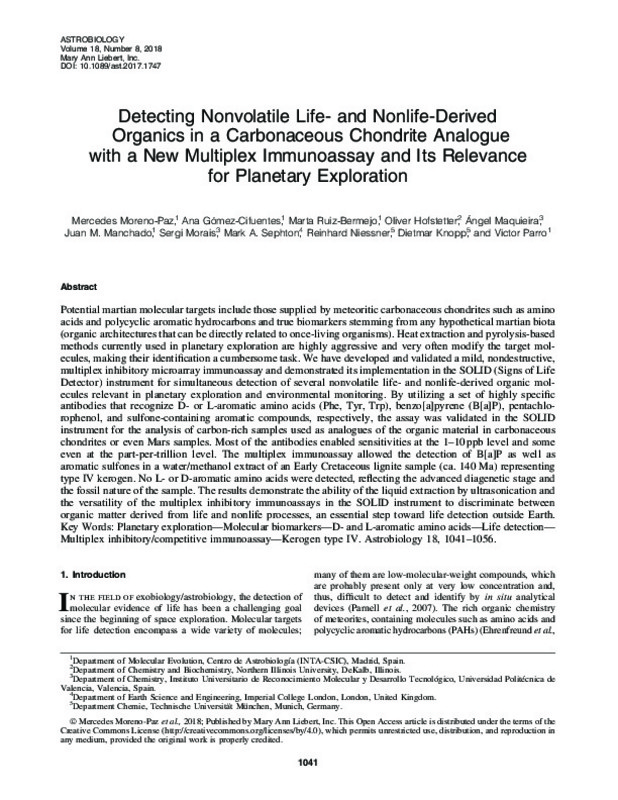Moreno-Paz, M.; Gómez-Cifuentes, A.; Ruiz-Bermejo, M.; Hofstetter, O.; Maquieira Catala, A.; Manchado, JM.; Morais, S.... (2018). Detecting Nonvolatile Life- and Nonlife-Derived Organics in a Carbonaceous Chondrite Analogue with a New Multiplex Immunoassay and Its Relevance for Planetary Exploration. Astrobiology. 18(8):1041-1056. https://doi.org/10.1089/ast.2017.1747
Por favor, use este identificador para citar o enlazar este ítem: http://hdl.handle.net/10251/147527
|
Título:
|
Detecting Nonvolatile Life- and Nonlife-Derived Organics in a Carbonaceous Chondrite Analogue with a New Multiplex Immunoassay and Its Relevance for Planetary Exploration
|
|
Autor:
|
Moreno-Paz, Mercedes
Gómez-Cifuentes, Ana
Ruiz-Bermejo, Marta
Hofstetter, Oliver

 Maquieira Catala, Angel
Manchado, Juan M.
Maquieira Catala, Angel
Manchado, Juan M.

 Morais, Sergi
Sephton, Mark A.
Niessner, Reinhard
Knopp, Dietmar
Parro, Victor
Morais, Sergi
Sephton, Mark A.
Niessner, Reinhard
Knopp, Dietmar
Parro, Victor
|
|
Entidad UPV:
|
Universitat Politècnica de València. Departamento de Química - Departament de Química
|
|
Fecha difusión:
|
|
|
Resumen:
|
[EN] Potential martian molecular targets include those supplied by meteoritic carbonaceous chondrites such as amino acids and polycyclic aromatic hydrocarbons and true biomarkers stemming from any hypothetical martian biota ...[+]
[EN] Potential martian molecular targets include those supplied by meteoritic carbonaceous chondrites such as amino acids and polycyclic aromatic hydrocarbons and true biomarkers stemming from any hypothetical martian biota (organic architectures that can be directly related to once living organisms). Heat extraction and pyrolysis-based methods currently used in planetary exploration are highly aggressive and very often modify the target molecules making their identification a cumbersome task. We have developed and validated a mild, nondestructive, multiplex inhibitory microarray immunoassay and demonstrated its implementation in the SOLID (Signs of Life Detector) instrument for simultaneous detection of several nonvolatile life- and nonlife-derived organic molecules relevant in planetary exploration and environmental monitoring. By utilizing a set of highly specific antibodies that recognize D- or L- aromatic amino acids (Phe, Tyr, Trp), benzo[a]pyrene (B[a]P), pentachlorophenol, and sulfone-containing aromatic compounds, respectively, the assay was validated in the SOLID instrument for the analysis of carbon-rich samples used as analogues of the organic material in carbonaceous chondrites or even Mars samples. Most of the antibodies enabled sensitivities at the 1-10ppb level and some even at the ppt level. The multiplex immunoassay allowed the detection of B[a]P as well as aromatic sulfones in a water/methanol extract of an Early Cretaceous lignite sample (c.a., 140 Ma) representing type IV kerogen. No L- or D-aromatic amino acids were detected, reflecting the advanced diagenetic stage and the fossil nature of the sample. The results demonstrate the ability of the liquid extraction by ultrasonication and the versatility of the multiplex inhibitory immunoassays in the SOLID instrument to discriminate between organic matter derived from life and nonlife processes, an essential step toward life detection outside Earth.
[-]
|
|
Palabras clave:
|
Planetary exploration
,
Molecular biomarkers
,
D- and L- aromatic amino acids
,
Life detection
,
Multiplex inhibitory/competitive immunoassay
,
Kerogen type IV
|
|
Derechos de uso:
|
Reconocimiento (by)
|
|
Fuente:
|
Astrobiology. (issn:
1531-1074
)
|
|
DOI:
|
10.1089/ast.2017.1747
|
|
Editorial:
|
Mary Ann Liebert
|
|
Versión del editor:
|
https://doi.org/10.1089/ast.2017.1747
|
|
Código del Proyecto:
|
info:eu-repo/grantAgreement/MICINN//AYA2011-24803/ES/DETECCION DE BIOMOLECULAS EN EXPLORACION PLANETARIA/
info:eu-repo/grantAgreement/UKRI//ST%2FN000803%2F1/GB/Planetary Origins and Evolution at Imperial (2016-2019)/
info:eu-repo/grantAgreement/MINECO//ESP2014-51989-P/
info:eu-repo/grantAgreement/MINECO//ESP2015-69540-R/ES/DETECCION DE BIOMOLECULAS EN EXPLORACION PLANETARIA/
|
|
Agradecimientos:
|
This work was supported by granted projects AYA2011-24803, ESP2014-51989-P, and ESP2015-69540-R, from the Ministry of Economy and Competitiveness (MINECO) of Spain, and by Grant No. ST/N000803/1 (United Kingdom). A. G-C ...[+]
This work was supported by granted projects AYA2011-24803, ESP2014-51989-P, and ESP2015-69540-R, from the Ministry of Economy and Competitiveness (MINECO) of Spain, and by Grant No. ST/N000803/1 (United Kingdom). A. G-C was a fellow of Plan de Formación from INTA.
[-]
|
|
Tipo:
|
Artículo
|









